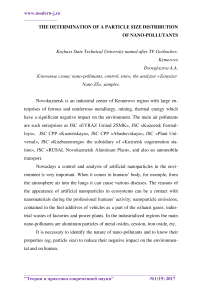The determination of a particle size distribution of nano-pollutants
Автор: Dvoeglazova A.A.
Журнал: Теория и практика современной науки @modern-j
Рубрика: Основной раздел
Статья в выпуске: 1 (19), 2017 года.
Бесплатный доступ
Nano-pollutants, control, snow, the analyzer "zetasizer nano zs", samples
Короткий адрес: https://sciup.org/140270067
IDR: 140270067
Текст статьи The determination of a particle size distribution of nano-pollutants
Novokuznetsk is an industrial center of Kemerovo region with large enterprises of ferrous and nonferrous metallurgy, mining, thermal energy which have a significant negative impact on the environment. The main air pollutants are such enterprises as JSC «EVRAZ United ZSMK», JSC «Kuznetsk Ferroal-loys», JSC CPP «Kuznetskaya», JSC CPP «Abashevskaya», JSC «Plant Uni-versal», JSC «Kuzbassenergo» the subsidiary of «Kuznetsk cogeneration sta-tion», JSC «RUSAL Novokuznetsk Aluminum Plant», and also an automobile transport.
Nowadays a control and analysis of artificial nanoparticles in the environment is very important. When it comes in humans’ body, for example, from the atmosphere air into the lungs it can cause various diseases. The reasons of the appearance of artificial nanoparticles in ecosystems can be a contact with nanomaterials during the professional humans’ activity; nanoparticle emissions, contained in the fuel additives of vehicles as a part of the exhaust gases; industrial wastes of factories and power plants. In the industrialized regions the main nano-pollutants are aluminum particles of metal oxides, cession, iron oxide, etc.
It is necessary to identify the nature of nano-pollutants and to know their properties (eg, particle size) to reduce their negative impact on the environmental and on human.
The aim of this work was the research of a particle size distribution of the nanoparticles in the snow waters of Novokuznetsk by the dynamic light scattering.
The size of the nanoparticles was determined by the analyzer «Zetasizer Nano ZS» («Malvern Instruments», England) using backscatter technology registration.
Snow samples were collected in the Zavodskoy district of Novokuznetsk and Novokuznetsk district. The sampling points are located on the border of the sanitary protection zone of the northern industrial hub and experiencing different degrees of anthropogenic load on the territory. Sampling was carried out at the same time in the period of maximum moisture content (in the beginning of March 2016) immediately prior to the melting of snow. Snow samples were cut in the form of cores to the full depth of the snow cover, placed in plastic bags and transported to the laboratory. Then the snow sample were transferred into glass containers, which melts at room temperature. To determine the particle size distribution of the aerosol particles of solid snow water subjected to uphold, the precipitate was analyzed by laser particle size, and the supernatant - by dynamic light scattering.
The studies identified that in the samples taken in the area of Novokuznetsk (eg vil. Shorokhova, the zone of the influence of industrial enterprises) nanochastts share (up 93%) has a size of 400-600 nm, at a fraction the size of 44-86 nm particles have to 7- 9 %. The sampling locations are characterized by the proximity of the highway with heavy traffic particle size larger 842 nm.
Thus, the share of nano-pollutants in common volume is very high, so the particle size analysis of suspended impurities is encouraged to include in the list of mandatory indicators for monitoring the pollution of the environment of industrial regions.
Список литературы The determination of a particle size distribution of nano-pollutants
- Bakhareva, The rapid assessment of the toxicity of a snow cover of the metallurgical district of Chelyabinsk /Bakhareva, Nokhrin // The messenger of young scientists of Chelyabinsk region. 2015. - № 3 (10). - S. 58-62.
- Zhuravleva, Pollution of asnow cover by polycyclic aromatic hydrocarbons and toxic elements on the example of Novokuznetsk / Zhuravlev [et al.] // Chemistry for sustainable development. -2014.- 22. - P. 445-454.


